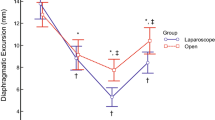Abstract
Purpose
Girdles and abdominal binders may reduce pain and stabilize the abdominal wall after laparotomy, but a risk for increased intra-abdominal pressure and decreased lung function is also hypothesized. The aim of this study was to investigate the effect of an abdominal girdle after midline laparotomy in a randomized controlled trial.
Methods
Twenty-three patients undergoing laparotomy were randomized to wear an elastic girdle postoperatively and 25 were randomized to no girdle. Pulmonary function was evaluated with; forced vital capacity (FVC), forced expiratory volume during one second (FEV1), peak expiratory flow (PEF), and cough PEF. Pain was recorded using a visual analog scale (VAS). All patients completed the ventral hernia pain questionnaire (VHPQ) before surgery and at the end of the study. Intra-abdominal pressure was measured via an indwelling urinary catheter. Wound healing was assessed from photographs.
Results
FVC, FEV1, PEF, and cough PEF were reduced by about 30 % after surgery, but there were no differences between patients with or without a girdle (ANOVA). Intra-abdominal pressure and wound healing were the same in both groups. Pain was significantly lower on day 5 in the girdle group (p = 0.004).
Conclusions
An individually fitted elastic girdle used after midline laparotomy was found to be safe, as this did not affect lung function, coughing, intra-abdominal pressure, or wound healing. The immediate decline in lung function after surgery is restrictive and due to anesthesia and the surgical procedure. Pain was significantly decreased in the girdle group. The study is registered at ClinicalTrials.gov, number NCT01517217.





Similar content being viewed by others
References
Cheifetz O, Lucy SD, Overend TJ, Crowe J (2010) The effect of abdominal support on functional outcomes in patients following major abdominal surgery: a randomized controlled trial. Physiotherapy Canada Physiotherapie Canada 62:242–253
Lindberg P, Gunnarsson L, Tokics L, Secher E, Lundquist H, Brismar B, Hedenstierna G (1992) Atelectasis and lung function in the postoperative period. Acta Anaesth Scan 36:546–553
Jensen AG, Kalman SH, Eintrei C, Fransson SG, Morales O (1993) Atelectasis and oxygenation in major surgery with either propofol with or without nitrous oxide or isoflurane anaesthesia. Anaesthesia 48:1094–1096
Parfrey PS, Harte PJ, Quinlan JP, Brady MP (1977) Pulmonary function in the early postoperative period. Br J Surg 64:384–389
Erb J, Orr E, Mercer CD, Gilron I (2008) Interactions between pulmonary performance and movement-evoked pain in the immediate postsurgical period: implications for perioperative research and treatment. Reg anesth pain med 33:312–319
Larson CM, Ratzer ER, Davis-Merritt D, Clark JR (2009) The effect of abdominal binders on postoperative pulmonary function. Am surg 75:169–171
Gronnier C, Wattier JM, Favre H, Piessen G, Mariette C (2012) Risk factors for chronic pain after open ventral hernia repair by underlay mesh placement. World J Surg 36:1548–1554
Miller MR, Hankinson J, Brusasco V et al (2005) Standardisation of spirometry. Euro Resp J 26:319–338
Clay L, Franneby U, Sandblom G, Gunnarsson U, Strigard K (2012) Validation of a questionnaire for the assessment of pain following ventral hernia repair-the VHPQ. Langenbeck's Arch Surg 397:1219–1224
Bianchi C, Baiardi P (2008) Cough peak flows: standard values for children and adolescents. Am J Phys Med Rehabil 87:461–467
Ishikawa Y, Bach JR, Komaroff E, Miura T, Jackson-Parekh R (2008) Cough augmentation in Duchenne muscular dystrophy. Am J Phys Med Rehabil 87:726–730
Park JH, Kang SW, Lee SC, Choi WA, Kim DH (2010) How respiratory muscle strength correlates with cough capacity in patients with respiratory muscle weakness. Yonsei Med J 51:392–397
Suarez AA, Pessolano FA, Monteiro SG et al (2002) Peak flow and peak cough flow in the evaluation of expiratory muscle weakness and bulbar impairment in patients with neuromuscular disease. Am J Phys Med Rehabil 81:506–511
Merei JM (2006) Umbilical hernia repair in children: is pressure dressing necessary. Ped Surg Int 22:446–448
Munegato G, Brandolese R (2001) Respiratory physiopathology in surgical repair for large incisional hernias of the abdominal wall. J Am Coll Surgeons 192:298–304
Grigorakos L, Sotiriou E, Koulendi D et al (2008) Preoperative pulmonary evaluation (PPE) as a prognostic factor in patients undergoing upper abdominal surgery. Hepato Gastroenterol 55:1229–1232
Mayo NE, Feldman L, Scott S (2011) Impact of preoperative change in physical function on postoperative recovery: argument supporting prehabilitation for colorectal surgery. Surgery 150:505–514
Abbas SM, Hill AG (2009) Smoking is a major risk factor for wound dehiscence after midline abdominal incision; case-control study. ANZ J Surg 79:247–250
Kulkarni SR, Fletcher E, McConnell AK, Poskitt KR, Whyman MR (2010) Pre-operative inspiratory muscle training preserves postoperative inspiratory muscle strength following major abdominal surgery—a randomised pilot study. Ann Roy Coll Surg 92:700–707
Acknowledgement
This study was supported by a grant from the Bengt Ihre Foundation and ALF founding SLL Dnr LS 0801-0019. Ms. Thyra Löwenmark is acknowledged for her help with statistics and database handling, and research nurse Mrs. Margareta Michanek for valuable practical help throughout the study.
Author information
Authors and Affiliations
Corresponding author
Rights and permissions
About this article
Cite this article
Clay, L., Gunnarsson, U., Franklin, K.A. et al. Effect of an elastic girdle on lung function, intra-abdominal pressure, and pain after midline laparotomy: a randomized controlled trial. Int J Colorectal Dis 29, 715–721 (2014). https://doi.org/10.1007/s00384-014-1834-x
Accepted:
Published:
Issue Date:
DOI: https://doi.org/10.1007/s00384-014-1834-x




